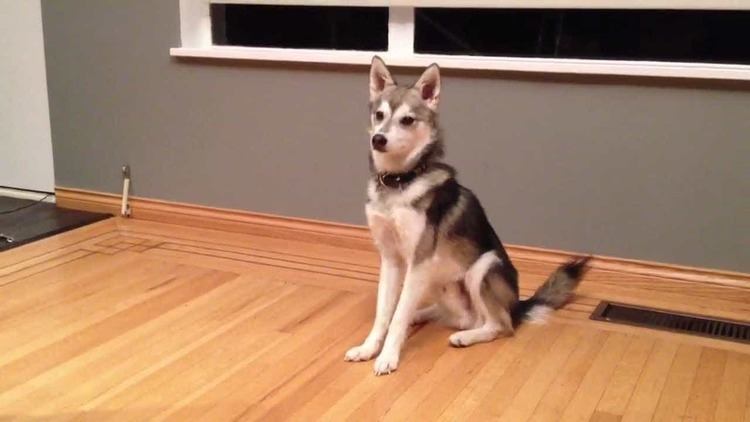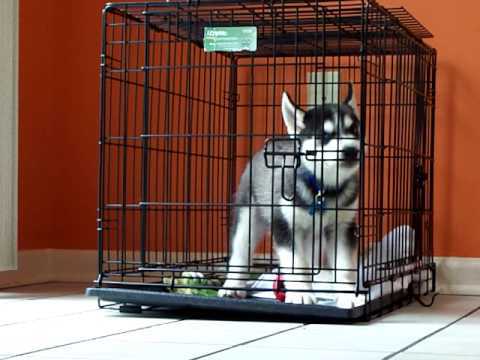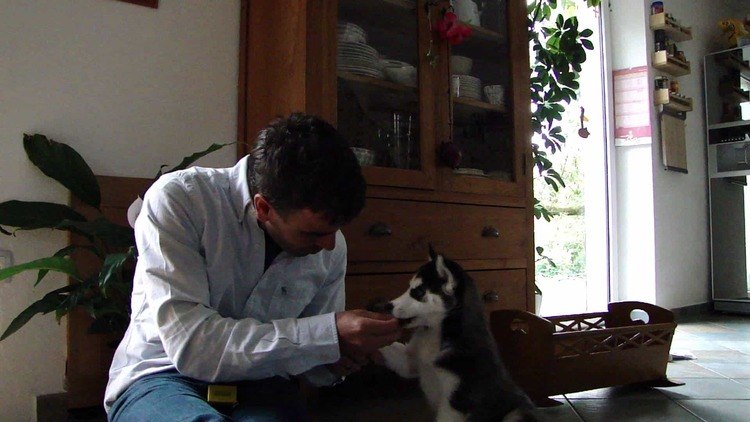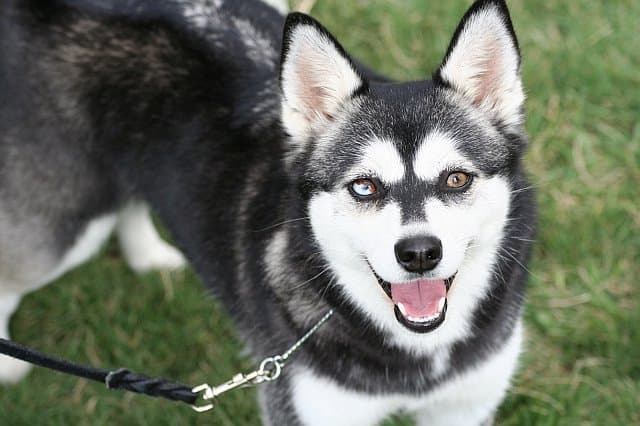It’s no secret that huskies are some of the most popular dog breeds in the world. They’re beautiful, charismatic and can be a lot of fun to train!
But there’s one thing you need to know before you get started: huskies are incredibly stubborn. The trick is figuring out how to use this trait when training them.
Huskies can make wonderful pets, but they do require some special handling in order to ensure that your life together with your new furry friend is happy and fulfilling for both of you.
Getting started with your training is really quite simple – providing that you know what needs doing from the outset! In this Husky Training Guide, we will outline why husky training should be carried out, and also some popular methods for getting the desired behavior from your pup.
Are Huskies Really That Hard To Train?

You’ve probably heard it said that huskies are a tough breed to train.
Is there any truth to the belief?
Well… yes.
Huskies are difficult to train for two reasons.
First, because they are independent thinkers who don’t always see the point in doing what you say, and second, because they are incredibly stubborn.
Once a husky has decided on something there is very little you can do to convince them otherwise – your best bet is often just to go along with it! Because of this many people find that huskies can be hard work to train.
However there are lots of things you can do to encourage good behaviour and discourage bad behaviour which will make life easier for both of you. With time, patience and consistency almost any husky can become a well mannered member of doggy society!
What Is The Best Way to Train A Husky?
The best way to train a husky is through positive reinforcement.
Scolding a husky will not work because it will only instill fear or resentment of the owner, resulting in an unhappy dog who obeys commands only grudgingly.
It’s also very difficult to scold a husky in any meaningful way – since they are so intelligent, they quickly learn how to evade reprimands. The most effective training methods for huskies are reward-based training (offering treats when the dog does something right) and clicker training (a tool where the owner makes a clicking noise followed by treating when the dog does what is desired.
Let’s take a look at some of the popular husky training methods, and what they’re useful for…
Husky Puppy Training Methods
There are lots of different ways to train your husky puppy; you should choose the method that best works for your circumstances, schedule and your dog’s personality.
It doesn’t really matter which one you pick; just that you do it consistently and with patience.
Different types of training work for different types of behavior too.
Crate Training
Best for: toilet training
Crate training is a reliable way to both toilet train and encourage your husky to feel comfortable and cozy in their own space.
As they see the crate as their own little home, they are unlikely to go to the toilet in it. This will ensure that they are more likely to go to the toilet when you take them outside at appropriate intervals.
Crate training is also great for giving your husky their own space and allows you to keep them safe without necessarily being in the same room as them – it may come in especially handy at night.

The first hurdle to overcome with crate training is actually encouraging your pup to embrace the crate as their own space. This should be done slowly but surely in order not to upset your husky.
Tips for making crate training a positive experience:
- When you first start out, put your puppy in the crate and leave the door open so that they can leave anytime they want.
- Line the crate with a familiar blanket or an old t-shirt that will provide them some comfort.
- Offer up lots of praise and some treats when they approach and go into the crate.
- Leave a treat or a toy inside the crate to tempt your pup in.
- When they’ve got used to the crate with the door open, start closing the door for 30-60 seconds at a time (after they have stopped whining) before opening it again.
- Keep gradually increasing the time with the door closed.
- Make sure the crate is plenty big enough for their size.
You can read more tips and tricks for crate training here.
Clicker Training
Best for: learning new commands
Clicker training is one of the best ways to teach and reinforce new behaviors with your pup. Both mini huskies and full size huskies are very intelligent and respond well to this memory-based method of training.
First off, you will need a clicker – a mechanical device that makes a distinct ‘click’ noise when you press it.
You will need to press the clicker every time your dog performs the correct behavior on cue during training. So, if you say “sit” and they sit, you should press the clicker. This will reinforce and show them that they are doing the right thing. This should be combined with praise and the occasional treat for exceptionally good behavior.
A click is more effective than a simple “good boy” because it is such a distinct and unusual sound – nowhere else will your pup hear that noise unless during their training. Voices obviously vary hugely in tone and volume whereas a click always sounds the same. Your mini husky will do weell with consistency.
Try the clicker training when you’re teaching new commands and even tricks.

Alpha of the Pack
As well as these short, regular bursts of training to mold these behaviors in your dog, as their owner you should command respect and be perceived by your husky to be the ‘alpha’ of the family.
All dogs have an innate ‘pack’ instinct dating back to their wolf ancestry. All packs revolve around a hierarchy of power – you need to be at the top of that hierarchy as the alpha, in order to ensure that your dog doesn’t take that role instead. If your dog perceives themselves as the alpha, they will likely indulge in a host of dominant, bad behaviors as a result.
Both you and your dog will be happier with you as the leader of your pack. Your dog gets to be secure in following you, while you don’t need to deal with a dog challenging your authority. Be sure to assert your leadership early on with your mini husky.
Here’s how to assert yourself as the alpha:
- Be confident and strong-willed when giving commands: don’t give in to whining or ignorance.
- If they ignore a command, walk away and don’t give them what they want. Try again with the command in a few minutes.
- Show that you “come first”: always lead your dog and enter through doorways first, for instance. Eating before your dog is also a good idea.
- Be firm yet fair: always reward good behavior and never use violence or shouting against your dog. Never display anger; just leadership.
- Build a helpful vocabulary to signal to your mini husky when they’re doing right or wrong: yes, no, stop, stay.

How to Discipline A Husky
If you’re getting a new puppy or adopting an older dog, here’s how to discipline your husky:
Step 1: Make sure your dog knows who’s boss (you!)
Your husky will need to know that it’s not his job to make decisions about where he sleeps or what kind of food he eats.
Huskies are a very independent breed, and they often rebel against the idea of being bossed around. Many huskies think that it’s their duty to test you to see if you really mean what you say.
Step 2: Nipping bad behavior in the bud
Huskies are excellent escape artists.
They’re also highly intelligent which means they learn new tricks very quickly. Hiding magnets or other household objects where your dog can’t reach them is one way to keep him out of trouble, but it won’t teach him anything about right and wrong behaviour.
You need to catch your dog doing something wrong while he’s in the act , then give him a firm “no” and redirect him to something that’s more appropriate. If your husky is caught in the act of chewing on an electric socket, you need to tell him firmly “no,” then give him a chew toy or rawhide bone instead.
Step 3: Don’t punish your dog for events that happened earlier.
Your husky will be confused if you punish him after the fact because he won’t know what he’s being punished for. If you punish your dog while he’s doing something wrong, he’ll learn how to associate his actions with consequences. With that said, positive reenforcement always works best with a husky.
Step 4: Exercise and discipline to prevent the bad behavior
Huskies are extremely energetic dogs that require lots of exercise. They need at least one hour of rigorous daily exercise, whether it’s playing fetch or running alongside your bicycle. If your husky is tired out from physical activity, he’ll be more likely to rest when you tell him to rest -and less likely to ignore you! A Siberian husky needs plenty of mental stimulation as well.
See more: tips to stop resource guarding
General Husky Training Tips
As well as the above methods for training your husky puppy, it’s always worth bearing in mind the following tips and ideas when you want to successfully train your dog.
- Consistency is key: short, daily sessions are best for teaching and reinforcing new behaviors with your puppy.
- Always reward good behavior: just like humans, dogs sometimes need an incentive. Small, bite-sized treats will keep them motivated and happy.
- Always supervise children: it’s great to involve children in the training process, just make sure that there’s always strict supervision.
- Set up a feeding schedule: for toilet training, it’s best if you have a set schedule that you repeat every day. For instance, in the evening, take your pup straight outside after feeding so that they can relieve themselves.
- Feed high quality food: your puppy’s toilet habits will be more consistent and healthy if they’re eating good foods – not cheap stuff high on fillers with little nutrition.
Now it’s time to start training!
Learn more: visit our Mini Husky Owner’s Guide
